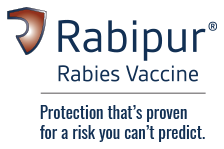RABIPUR is indicated for active immunisation against rabies in people of all ages. RABIPUR should be used in accordance with official recommendations.

As a registered member of Bavarian Nordic, you can request a visit from a Bavarian Nordic representative.
RABIPUR is indicated for active immunisation against rabies in people of all ages. RABIPUR should be used in accordance with official recommendations.

Folkhälsomyndigheten recommend prophylaxis rabies vaccination for the following:
RABIPUR triggers an effective immune response to the rabies virus before and after rabies exposure, so it can be used as a pre-exposure prophylaxis vaccine (PrEP) as well as for post-exposure prophylaxis (PEP)
PrEP
*(RIG) should not be administered to previously vaccinated patients
PEP
In adults and children, the recommended dose for both primary immunisation and boosters is 1.0 mL
During 2019 Folkhälsomyndigheten published new recommendations for rabies prophylaxis which follow the WHO guidelines. The number of doses of the rabies vaccine have been changed in comparison to the previous recommendations.

RABIPUR’s rapid scheme gives the flexibility to vaccinate adults who require urgent pre-exposure protection
Not every animal bite requires rabies post-exposure prophylaxis
When suspect rabid animal contacts (excluding bats) occur in areas free of carnivore-mediated rabies and where there is adequate surveillance in place, PEP may not be required. The decision must be based on expert risk assessment
| Category of exposure | Type of exposure to a domestic or wild a) animal suspected or confirmed to be rabid, or animal unavailable for testing | Recommended post-exposure prophylaxis |
|---|---|---|
| I |
Touching or feeding animalsLicks on intact skinContact of intact skin with secretions or excretions of a rabid animal or human case |
None, if reliable case history is available. |
II |
Nibbling of uncovered skinMinor scratches or abrasions without bleeding |
Administer vaccine immediately b)Stop treatment if animal remains healthy throughout an observation period of 10 days c) or is proven to be negative for rabies by a reliable laboratory using appropriate diagnostic techniques. |
III |
Single or multiple transdermal bites d) or scratches, licks on broken skin.Contamination of mucous membrane with saliva (i.e. licks). Exposure to bats. e) |
Administer rabies vaccine immediately, and rabies immunoglobulin, preferably as soon as possible after initiation of post-exposure prophylaxis. Rabies immunoglobulin can be injected up to 7 days after first vaccine dose administration.Stop treatment if animal remains healthy throughout an observation period of 10 days or is proven to be negative for rabies by reliable laboratory using appropriate diagnostic techniques |

Center for Disease Control. Yellow Book. Chapter 4. 2020. https://wwwnc.cdc.gov/travel/
RABIPUR Summary of Product Characteristics (updated September 2020). Available at: https://www.medicines.org.uk/emc/product/2502/smpc (accessed April 2020).
Rekommendationer om förebyggande åtgärder mot rabies — Folkhälsomyndigheten (folkhalsomyndigheten.se) Pubished June 2019.
World Health Organization (WHO). Guide for rabies pre and post exposure prophylaxis in humans. Available at: https://www.who.int/rabies/PEP_Prophylaxis_guideline_15_12_2014.pdf (accessed April 2020).
World Health Organization (WHO). Rabies Fact Sheet. Available at: https://www.who.int/news-room/fact-sheets/detail/rabies (accessed 17 Dec 2021).